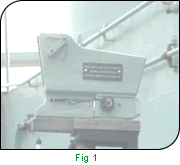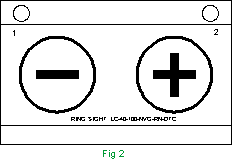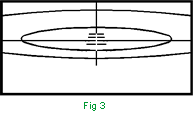Description

The sight is a unit power, solid glass, reflex collimator sight designed for the heavier direct fire small arms or cannons. It is designed for easy surveillance and target acquisition engagement. Because of the solid glass optic they need no maintenance and cannot mist up. This type of sight is an up to date replacement for traditional open or cartwheel sights. Because the graticule pattern is seen at infinity against the target the firers eye position is not constrained and can move sideways, up and down, fore and aft within wide enough limits to make tracking the target and shooting easy.
The optic is constructed from solid glass with flat front and rear surfaces parallel to 3 minutes of arc. The rear surface is inclined to avoid reflections. The optic is potted into the housing with its optical axis aligned parallel to the weapon interface to 2 mils. One advantage of the Ring Sight is its large aperture, 40 x 30 mm, making it the choice for pintle mounted gun where the firer wants the maximum eye freedom as he moves around the pintle. so the gunner does not have to position his eye precisely (up down, sideways and in and out) unlike conventional optical day and night sights which have limited eye freedom in all these directions.
The sight uses a reflex collimator with no magnification . It uses ambient light by day and for low light and in the dark the graticule is lit by an in-built LED array, always in place. The LED array is powered by two lithium thionyl chloride 1/2 AA batteries (giving an excellent temperature range) : the brightness is adjusted by the gunner to suit the conditions. This means that low ambient light can be enhanced when needed and that NVG can be used without affecting their control. The LC-40-100-NVG-RN-DTC is the latest design with improved piezoelectric switches to be used on 20 and 30 mm naval cannons.
The LC-40-100 can be fitted with interchangeable filters for use in bright sun, laser protection, etc.
LED Array
The LED array has five red LED’s assembled onto a flashed opal diffuser. The array is connected, via a connection box to the power supply.
The LED array will remain on for approximately twenty minutes after switching on: this is normally long enough for an engagement. Press the correct switch to switch it on again. Brightness adjustment will be needed if there is no response when a switch is pressed, press both switches simultaneously, this resets the system.

The unit has two modes. Normal daylight mode and night vision goggle (NVG) mode.
The unit is switched on by pressing either the + or – switch. Using the + switch the unit switches on at the minimum graticule illumination for normal daylight use. Using the – switch the unit switches on at the maximum graticule illumination for night vision goggle use. Pressing both buttons together will change modes. Pressing the + switch increases the graticule illumination in steps until the maximum for the selected mode is reached. Pressing the – button decreases the graticule illumination in steps until the minimum for the selected mode is reached.
If 20 minutes has expired since the last button press, the unit will power off.
The unit has two battery cell compartments. The forward cell (1) mounted on the left side of the unit has priority and is used until discharged. When the left hand cell is discharged, the rearward cell (2) mounted on the right side of the unit is automatically selected and used as a backup until it is discharged or the left hand battery is replaced. When the unit is switched on, two LED’s, mounted above the control switches, show the state of the batteries. The unit varies the brightness of the battery indicator LED’s to match the operating mode.
The LEDs have the following meaning: -
Status |
Left hand LED, marked (1). |
Right hand LED, marked (2). |
On |
shows the left hand battery is being used. | shows the right hand battery capacity is satisfactory as a backup. |
Off |
shows that the left hand battery is exhausted and should be replaced. | shows that the right hand battery capacity is not satisfactory and should be replaced. |
If the unit is running with both LED’s off, the operating time left will be short.
Graticule

If air targets are to be engaged the graticule has radial lines to assist the gunner in choosing a suitable point of aim as shown in Fig 2. Graticule patterns can be provided to suit the expected engagements and the ballistics for the particular gun. The elevation and lead available on the graticule plate are more than adequate for the ranges and crossing speeds that can be used by the gunner. As the graticule plate is built in production, the pattern must be agreed for any order. To view the range of different Garticules we have to offer, click here.
The graticule is formed by a photo plate cemented between the prism block and the light wedge. The graticule is focused at infinity by a Plano-Doublet Reflector focusing being done entirely within the optic. The equivalent focal length for graticule calculations is 132mm. The Plano-Doublet Reflector consists of a Dichroic Beam-Splitter optimised for high reflection in the red end of the spectrum and high transmission in the blue end, to enable NVG minimum loss of light.
A filter is fitted at the front of the optic, for use in bright conditions. When required it can be rotated in position.
Accessories
Battery Changing
The forward battery will always be switched on first and its indicator light will light. When this battery is exhausted the LED array will automatically switch to the other battery and its indicator will come on. The exhausted battery should be replaced as soon as possible.
Weapon Interface
The weapon interface is a dovetail Part No ME301535-R made to match the Royal Ordnance female dovetail.
Cloth Cover
A drawstring cloth cover Part No 40-100-CC-RN is provided to protect the sight when in position.
Storage Case
A grey case Part no 40-100-PC-RN is provided for the sight when not in use. It is provided with foam liners.
 |
Nato Stock Numbers
|






